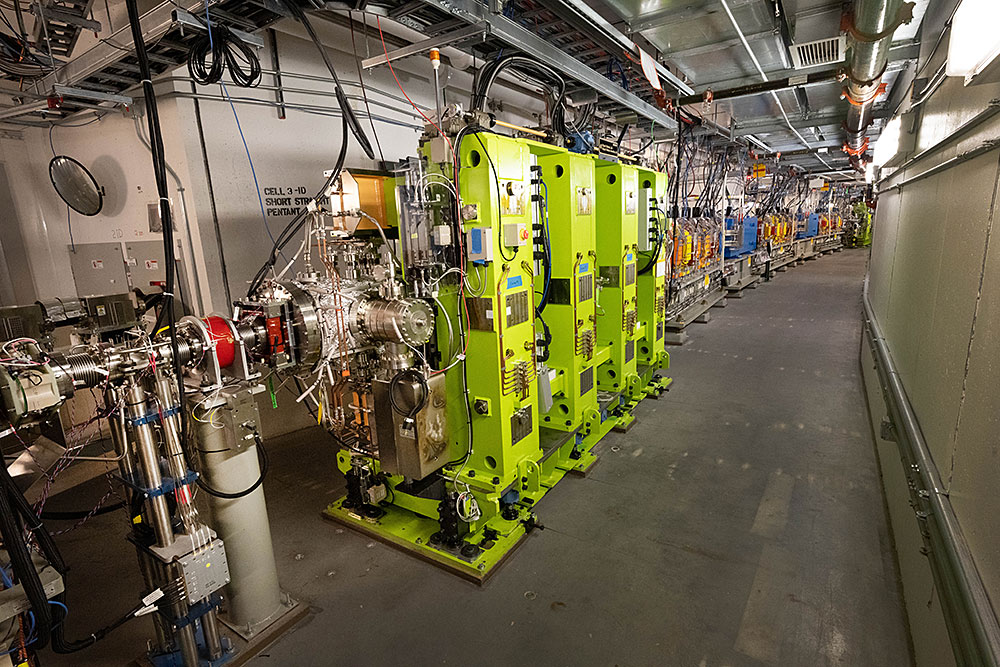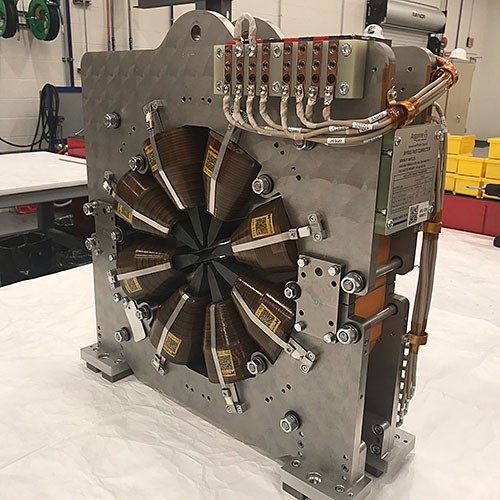Building Particle Accelerators Takes More Than a Village
From magnets to power supplies, NSLS-II experts support accelerator upgrades across the Nation
January 25, 2023
 enlarge
enlarge
The photo shows a view of the National Synchrotron Light Source II (NSLS-II) accelerator tunnel located at the U.S. Department of Energy's Office of Science Brookhaven National Laboratory.
Each year, thousands of people travel far and wide to see architectural marvels such as the towering steps of the Kukulcán temple in in Chichen Itza or the intricate facade of the Cologne Cathedral in Germany. Like these marvels of history and culture, thousands of researchers travel to the U.S. Department of Energy’s (DOE’s) five light source facilities each year. They don’t come for the views, though, they come to push the boundaries of science—in fields ranging from batteries to pharmaceuticals—by using the ultrabright synchrotron light, mostly x-rays, from these facilities to conduct experiments.
This light doesn’t just appear out of nowhere. It needs to be generated by large, complex particle accelerators. And, to keep the x-rays as bright as possible, scientists and engineers are working constantly to advance them. This story highlights ongoing collaborative projects of the Accelerator Division at the National Synchrotron Light Source II (NSLS-II), located at DOE’s Brookhaven Lab.
According to historical sources, it took the Germans over 600 years to build the original Cologne Cathedral, while archeologists speculate that the Temple of Kukulcán took at least 200 years to build in two phases. Thousands of people worked on these monuments during these extremely long construction periods. This is a feat they share with modern particle accelerator projects. While the initial construction of NSLS-II took only a decade, it still involved an international effort of hundreds of people from many disciplines and professions.
From the civil engineering challenges of the building design to the construction of the hundreds of magnets inside the accelerator, it truly takes more than a village to build a particle accelerator for a synchrotron light source. Similarly, many modern accelerator projects span multiple institutions and countries to leverage the expertise in the field.
“Our accelerator experts possess a wealth of expertise and hands-on experience that they successfully applied during the construction of NSLS-II,” said Timur Shaftan, NSLS-II accelerator division director. “Now, we are sharing this knowledge through our active partnerships with other major accelerator projects in the US, advancing accelerators across the Nation.”
NSLS-II experts are working with three of the other four DOE light sources to support their ongoing upgrades.
Rome wasn’t built in a day
Two of the major upgrades underway at light sources in the U.S. are fundamental leaps forward in accelerator technology. Light sources such as NSLS-II use billions of electrons to generate their x-rays. At the heart of these facilities, the electrons are propelled in large groups, called bunches, through thousands of feet of beam pipe.
In circular light sources, hundreds of magnets keep the electrons in their orbit around the ring. These magnets are arranged in a very specific way, called a magnetic lattice (most lattices used today are based on the Chasman–Green or double-bend achromat lattice), which allows scientists to add additional devices to the ring. These additional devices, called insertion devices, are essential for a light source because they can generate particularly bright beams of synchrotron light by amplifying a natural property of electrons. Whenever electrons travel at nearly lightspeed around a corner, they emit x-rays. By moving the electrons through long slalom courses, their emitted x-rays are amplified. Insertion devices are exactly that: slalom courses for electrons.
The fundamental leap in accelerator technology now underway is the next step in the evolution of lattices. The original Chasman–Green lattice was developed for the original NSLS in the 1970s by Brookhaven researchers Renate Chasman and George Kenneth Green. The Chasman–Green lattice ushered light sources into a new era, but today’s scientific challenges require brighter x-rays than ever before.
Just as the invention of concrete or steel frames for skyscrapers allowed humanity to reach further into the sky, new technological developments in accelerator physics and engineering enabled scientists to create a new arrangement that produces even brighter beams of x-rays. This array is called a “multi-bend achromat lattice.” Two light sources in the U.S.—the Advanced Light Source (ALS) at Lawrence Berkeley National Laboratory and the Advanced Photon Source (APS) at Argonne National Laboratory—are on the verge of replacing their old particle accelerators with new, brighter ones that use this new lattice.
 enlarge
enlarge
One of the eight-pole fast-corrector magnets that Brookhaven engineers designed and built for the APS upgrade project. It was the 1,000th magnet to arrive at Argonne for use in the APS Upgrade. Photo: Nicholas Bechtold.
Such significant upgrades for both facilities require hundreds of new magnets to steer the electrons. The NSLS-II Accelerator Division has supported the APS Upgrade by designing and overseeing the manufacture of 165 magnets of the 1,352 being fabricated for the APS accelerator complex.
“The magnets we designed are very versatile. They have eight poles, which allows them to better stabilize the electron beam in multiple directions simultaneously and around the entire ring. Without them, the electron beam would wobble along the orbit, which would smear out the x-ray beam. The more stable the electron beam is, the better the quality of the synchrotron light,” said Sushil Sharma, a mechanical engineering expert at NSLS-II.
But the magnets are not the only component the NSLS-II team is working on for the APS upgrade.
“We are working on four different contracts for the APS, including instrumentation for detection and management of the electron beam and interlocks to ensure the safety of the people working on with the accelerator. Overall, we are pleased to support such an important upgrade project at the APS,” said Danny Padrazo, diagnostics and instrumentation group leader at NSLS-II.
While the NSLS-II team is not working on magnets for the ALS upgrade—the second major upgrade project—they have been working on something just as important: power supplies.
“We’ve partnered with our colleagues at ALS for the last four years to design, develop, build, test, and deliver 1,000 power supplies to the ALS. That’s a $25-million-dollar project alone,” explained Greg Fries, NSLS-II deputy accelerator division director.
George Ganetis, electrical engineering expert at NSLS-II, added: “These power supplies are among the best in the world in terms of their capabilities, performance, and compact footprint. They are extremely stable, which is very important when you are operating a particle accelerator.”
Not your run-of-the-mill construction project
Closer to home, the team is partnering with Brookhaven’s Collider-Accelerator Department to advance the Lab’s newest large project: the Electron-Ion Collider (EIC). The EIC will be a two-and-a-half-mile-long accelerator that will collide electrons with protons and other ions (the nuclei of atoms). With each collision, scientists will be able to glimpse inside the ions to learn more about their inner building blocks (the quarks and gluons that make up protons and neutrons) and the fundamental force that holds these building blocks together.
When humanity learned how electrons work and about the details of the electromagnetic force, we were able to build circuits, computers, and so much more. By understanding the fundamental force that operates in atomic nuclei (the strong nuclear force), scientists will learn how the tiniest building blocks build up the mass and other properties of matter. This knowledge could be the key to discovering the technologies of the future.
At EIC, the NSLS-II team is supporting the design of the accelerator’s magnetic lattice. Although EIC is a collider, it still uses an arrangement of magnets to steer the particle beams. The team is helping with and considering expanding the scope of work on beam diagnostics, vacuum systems, and power supplies.
Has Elvis left the building?
With all these other accelerator projects going on around the country and at Brookhaven, one may wonder if the NSLS-II Accelerator Division has “moved on” from NSLS-II to all these new machines. But that couldn’t be further from the truth.
“All of the additional projects for other accelerators allow us to keep our skills sharp and continuous learn best practices in our complex, rapidly changing field,” said Fries.
Shaftan added, “In addition to the benefits to our skills and the projects, all of these projects are a great warm-up exercise in preparation of a future NSLS-II upgrade.”
As was the case with APS and ALS, the next stage for NSLS-II may involve a full-scale replacement of its accelerator. While the roadmap for the future facility upgrades is being assessed, the Accelerator Division maintains their expertise by actively working on U.S. upgrade projects. These efforts provide valuable experience for the development of Brookhaven’s next light source. The Accelerator Division is working to develop a light source with capabilities that extend beyond the reach of the current upgrades around the world, and these activities are part of the strategy to achieve that goal.
The Advanced Light Source (ALS), located at DOE’s Lawrence Berkeley National Laboratory, the Advanced Photon Source (APS), located at DOE’s Argonne National Laboratory, the Linac Coherent Light Source (LCLS), located at DOE’s SLAC National Accelerator Laboratory, and the National Synchrotron Light Source II (NSLS-II), located at DOE’s Brookhaven National Laboratory, are all U.S. Department of Energy Office of Science user facilities. To learn more about these user facilities, visit DOE’s website. The projects described here are funded through these facilities and the Department of Energy.
Brookhaven National Laboratory is supported by the U.S. Department of Energy’s Office of Science. The Office of Science is the single largest supporter of basic research in the physical sciences in the United States and is working to address some of the most pressing challenges of our time. For more information, visit https://energy.gov/science.
Follow @BrookhavenLab on Twitter or find us on Facebook.
2023-21067 | INT/EXT | Newsroom









